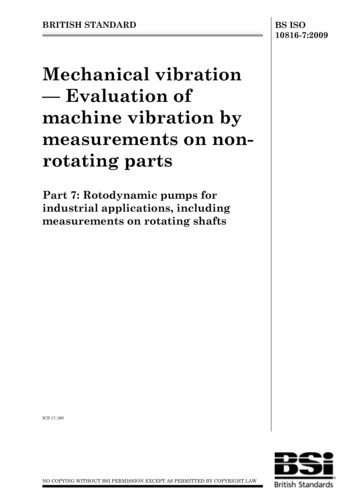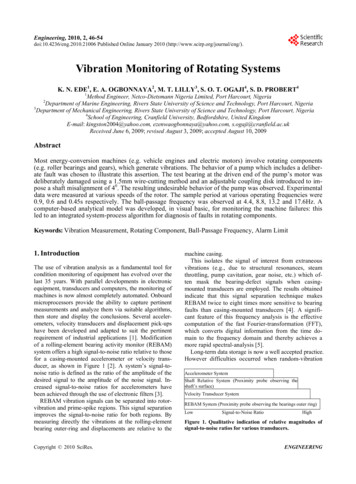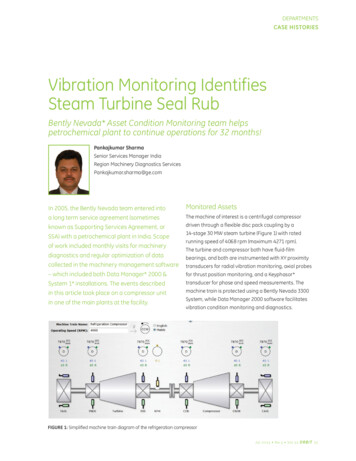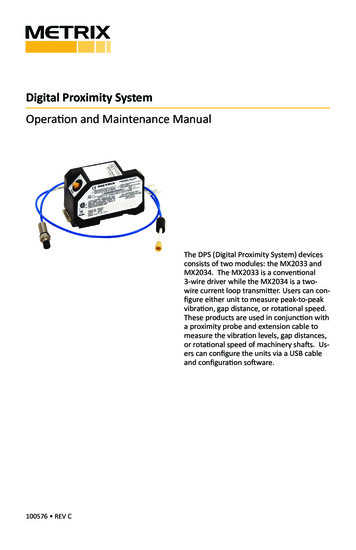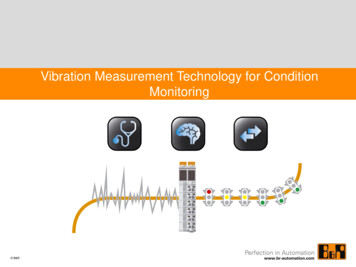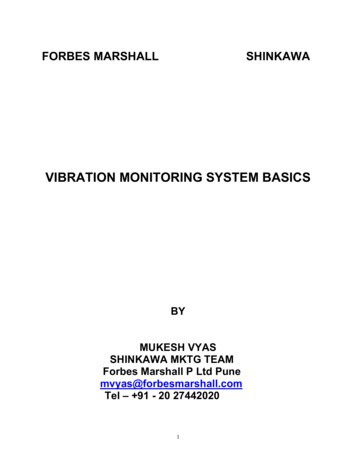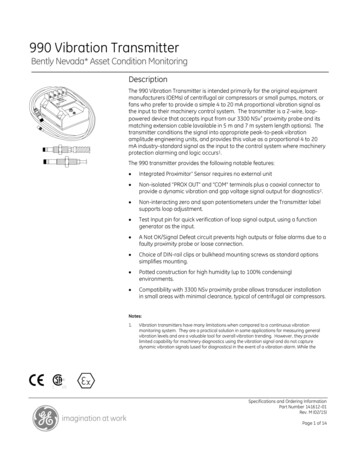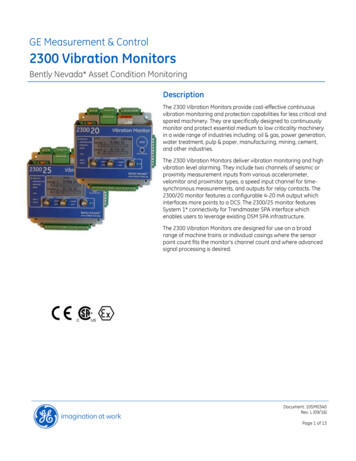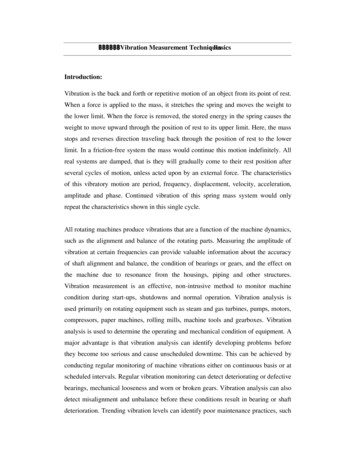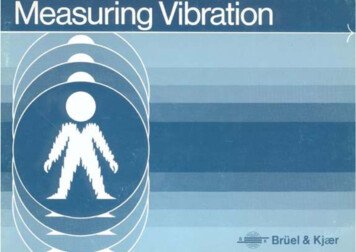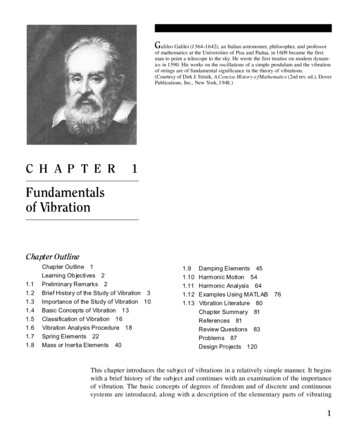
Transcription
The Role of Vibration Monitoring in Predictive MaintenanceDr. S. J. Lacey, Engineering Manager Schaeffler (UK) Limited
The Role of Vibration Monitoringin Predictive MaintenanceDr. S. J. Lacey, Engineering Manager Schaeffler (UK) LimitedSummaryUnexpected equipment failures can be expensive and potentially catastrophic, resulting in unplannedproduction downtime, costly replacement of parts and safety and environmental concerns.Predictive Maintenance (PdM) is a process for monitoring equipment during operation in order to identifyany deterioration, enabling maintenance to be planned and operational costs reduced. Rolling bearingsare critical components used extensively in rotating equipment and, if they fail unexpectedly, can result ina catastrophic failure with associated high repair and replacement costs. Vibration based conditionmonitoring can be used to detect and diagnose machine faults and form the basis of a PredictiveMaintenance strategy.1. IntroductionAs greater demands are placed on existing assets in terms ofhigher output or increased efficiency, the need to understandwhen things are starting to go wrong is becoming moreimportant. Add to this the increasing complexity andautomation of plant and equipment, it becomes moreimportant to have a properly structured and fundedmaintenance strategy. There is also a need to understand theoperation of equipment so that improvements in plant outputand efficiency can be realised. In today’s increasinglycompetitive world all of these issues are of key importanceand can only be achieved through a properly structured andfinanced maintenance strategy that meets the business needs.Maintenance can often be a casualty as businesses seek tosave costs. How often have we heard the words “we have hadno problems since the equipment was installed so we don’tneed condition monitoring”. This is often borne out ofignorance and not undertaking a proper risk assessment toidentify the criticality of existing assets so that the potentialreturn on investment (ROI) of a properly funded maintenancestrategy can be determined.The need to run a plant at a higher efficiency yet often withfewer people puts increasing pressure on all concerned whenequipment fails prematurely. When equipment does fail it isoften at the most inconvenient time, either in the middle of akey process, at a weekend or in the middle of the night, whenobtaining replacement parts may be difficult and labour costsare high due to overtime. While there is never a good time forequipment to fail, the technology available today means thatthere is simply no excuse for not taking the necessary stepsto protect key assets. This can be achieved by minimising therisk of early and unexpected failures through a properlystructured and funded maintenance strategy which willultimately reduce overall operational costs.Page 2The cost of not having a robust maintenance strategy shouldnot be underestimated. It should not be looked at simply asan upfront cost, but viewed as an investment to safeguard andprotect key assets, reducing the need for costly repairs andprotecting the output of key processes. In some industries,maintenance is now the second largest or even the largestelement of operating costs. As a result, it has moved fromalmost nowhere to the top of the league as a cost controlpriority in the last two or three decades.The need to contain costs and run plant for longer morereliably means that there is a growing awareness of the needto prevent unnecessary equipment failures. Central to this is amaintenance strategy which is based on monitoring key assetsto detect when things are starting to go wrong, enabling plantoutage to be better planned in terms of resource availability,spare components, repairs etc. As a result, the risk of missingimportant contract deadlines is reduced and customerconfidence is improved.Until recently, many industries have and still do take thereactive approach to maintenance since this has no upfrontcosts but can result in many hours or days of plant downtimeand/or lost production. While this may have been acceptablein the past, the increasing complexity and automation ofequipment has meant this is not now a cost-effective option.Having a clear and robust maintenance strategy fullysupported by senior management is becoming more important,particularly in industries where it not only has a major impacton costs but also on the health and safety of employees andin situations where secondary damage and a catastrophicfailure may result.
2. Maintenance Approach2.1. Reactive MaintenanceMaintenance is traditionally performed in either time basedfixed intervals as so-called preventive maintenance, or bycorrective maintenance when a breakdown or fault actuallyoccurs. In the latter, it is often necessary to perform themaintenance actions immediately, but in some cases this maybe deferred depending on the criticality of the equipment.With predictive maintenance, an advanced warning is given ofan impending problem and repairs are only carried out whennecessary and can be planned to avoid major disruption.A summary of all three approaches is given in Figure 1 anddiscussed briefly below:Reactive maintenance of machinery, often referred to as the“run till failure” approach, involves fixing problems only afterthey occur. Of course, this is the simplest and cheapestapproach in terms of upfront costs for maintenance, but oftenresults in costly secondary damage along with high costs as aresult of unplanned downtime and increased labour and partscosts. Since there are no upfront costs, it is often seen as aneasy solution to many maintenance strategies – or there is nostrategy at tiveMaintenanceHigh replacementcosts - partsreplaced too earlyHigh upfront costsincluding equipment& trainingDISADVANTAGESHigh risk ofcatastrophic failureor secondarydamage. High repair& replacement costsLoss of key assetsdue to highdowntime. Lostproduction & missedcontract deadlinesInventory - high costof spare parts orreplacementequipmentRisk of early failure- infant mortalityHuman error duringreplacement ofrepaired or new partsWith Preventive Maintenance (PM), machinery is overhauledon a regular basis regardless of the condition of the parts.This normally involves the scheduling of regular machine/plantshutdowns, whether or not they are required. The process maycut down failures before they happen but it also leads toincreased maintenance costs as parts are replaced when thisis not necessarily required.Increased Health& Safety risksEnvironmentalconcernsADVANTAGESSeen as aneasy optionMaintenance isplanned and helps toprevent unplannedbreakdownsFewer catastrophicfailures resulting inexpensive secondarydamageGreater control overinventoryThis can have disastrous consequences in terms of poorquality output, reduced plant efficiency or equipment failure.Monitoring the condition of rolling bearings is thereforeessential and vibration based monitoring is more likely todetect the early onset of a fault.2.2 Preventive MaintenanceParts may often havemany years ofserviceable liferemainingHigh labour cost– overtime,subcontracting.High cost due tohire of equipmentNo upfront costs,e.g. equipment,training.In rotating equipment, rolling element bearings are one of themost critical components both in terms of their initial selectionand, just as importantly, in how they are maintained.Bearing manufacturers give detailed guidelines as to whatmaintenance is required and when which is often overlooked.Risk of unexpectedbreakdowns arereducedEquipment life isextendedReduced inventory& labour costsMaintenance can beplanned and carriedout when convenientThere is also the risk of infant mortality due to human errorduring the time the asset is taken out of service for repair,adjustment, or installation of replacement parts. Other risksinclude installing a defective part, incorrectly installing ordamaging a replacement part, or incorrectly reassemblingparts.A frequent and direct result of preventive maintenance is thatmuch of the maintenance is carried out when there is nothingwrong in the first place. If the plant can be monitored in sucha way as to obtain advance warning of a problem, significantcosts savings can be obtained by avoiding unnecessary repairwork. Such an approach is known as Predictive Maintenance.Reduced risk ofHealth & Safety& environmentalincidentsOpportunity tounderstand whyequipment has failedand improveefficiencyFigure 1. Comparison of different types of maintenancePage 3
2.3 Predictive MaintenancePredictive Maintenance (PdM) is the process of monitoring thecondition of machinery as it operates in order to predict whichparts are likely to fail and when. In this way, maintenance canbe planned and there is an opportunity to change only thoseparts that are showing signs of deterioration or damage.The basic principle of predictive maintenance is to takemeasurements that allow for the prediction of which parts willbreak down and when. These measurements include machinevibration and plant operating data such as flow, temperature,or pressure.Replacing a bearing in a gearbox is preferable to replacing thewhole gearbox, and replacing a motor bearing is better thanhaving to send the motor to a rewinder to make expensiverepairs and replace parts.At the heart of many Predictive Maintenance strategies isCondition Monitoring which detects potential defects in criticalcomponents e.g. bearings, gears etc at the early stage therebyenabling the maintenance activity to be planned, saving bothtime and money and preventing secondary damage toequipment which can often be catastrophic.3. Identifying Asset CriticalityContinuous monitoring detects the onset of componentproblems in advance, which means that maintenance isperformed only when needed. With this type of approach,unplanned downtime is reduced or eliminated and the risk ofcatastrophic failure is mitigated. It allows parts to be orderedmore effectively, thereby minimising inventory items, andmanpower can be scheduled, thereby increasing efficiency andreducing the costs of overtime.The main benefits of PdM are:Improved machine reliability through the effective predictionof equipment failures.Reduced maintenance costs by minimising downtimethrough the scheduling of repairsIncreased production through greater machine availabilityLower energy consumptionExtended bearing service lifeImproved product qualityRolling bearings are often a key element in many differenttypes of plant and equipment spanning all market sectors.On one hand they can be of a standard design, readilyavailable and low cost commodity items costing only a fewpounds, such as those in electric motors, fans and gearboxes,while on the other hand they can be of bespoke design withlong lead times and cost hundreds of thousands of pounds, asis the case in wind turbines, steelmaking plant etc.However, they have one thing in common: if they failunexpectedly, they can result in plant and equipment outageresulting in lost production costing from a few thousand tomany millions of pounds. With a Predictive Maintenancestrategy, such large costs can be avoided by giving advancewarning of a potential problem, enabling remedial action to beplanned and taken at a convenient time.Page 4Rolling bearings are used extensively in almost every type ofrotating equipment whose successful and reliable operation ishighly dependent on the bearing type, bearing fits andinstallation and maintenance requirements, such asrelubrication.When rolling bearings deteriorate it can result in expensiveequipment failures with high associated costs. Unplanneddowntime, the costly replacement of equipment, health andsafety issues and environmental concerns are all potentialconsequences of a maintenance strategy that fails to monitorand predict equipment problems before they escalate into amore serious situation.Assessing the criticality of an asset to the overall operation ofthe plant is therefore essential in terms of determining thetype of condition monitoring required and whether it isnecessary at all. In some cases where a plant has a largenumber of low cost assets, where replacements are readilyavailable and/or are not deemed critical, a reactive orpreventive approach may well be appropriate.Even if an asset does warrant condition monitoring, a decisionmust be made not only on the technology but also on whetherthe asset warrants continuous (online system) or noncontinuous (patrol) monitoring. To help with this decision,assets are often assigned to one of three categories(1)depending on their criticality, Figure 2 .
CategoryDescriptionEconomicsAEquipment assets having alarge impact on plantoutput; equipment thatrepresents significantrepair costs; equipmentwith significant health &safety impacts. Failurescan occur very suddenlyand do not always giveadvance warning.Failures are veryexpensive due to lostproduction, health & safetyimpacts or environmentalimpact. Examples includelarge horsepower, highenergy density machineswith very high replacementand maintenance costs.Financial justification:prevention of lostproduction, reducedmaintenance costs,protection of lifeand environmentBEquipment assets havinga lesser impact on plantoutput; equipment withmoderate repair costs;equipment that can havehealth & safetyimplications if failureoccurs. Failures canoccur relatively quickly,but usually with someadvance warningSimilar to economics ofcritical equipment assets,but of smaller magnitude.Typical examples includemedium horsepowermachines with moderatereplacement andmaintenance costsCEquipment assets havinglittle or no direct impact onplant output; equipmentthat represents limitedrepair costs; equipmentthat has minor safetyramificationsTypically include smallerassets with small individualreplacement & repaircosts & little or no costsrelated to lost production.However, they collectivelycomprise a largepercentage of annualmaintenance costs.Small individual repair &re
Vibration based condition monitoring can be used to detect and diagnose machine faults and form the basis of a Predictive Maintenance strategy. Page 2. 2. Maintenance Approach Maintenance is traditionally performed in either time based fixed intervals as so-called preventive maintenance, or by corrective maintenance when a breakdown or fault actually occurs. In the latter, it is often .
